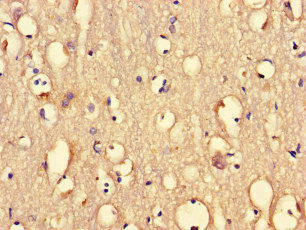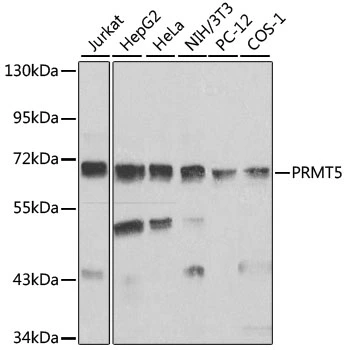PRMT5 antibody [N3C3]
GTX115409
ApplicationsImmunoFluorescence, Western Blot, ImmunoCytoChemistry, ImmunoHistoChemistry, ImmunoHistoChemistry Paraffin
Product group Antibodies
TargetPRMT5
Overview
- SupplierGeneTex
- Product NamePRMT5 antibody [N3C3]
- Delivery Days Customer9
- Application Supplier NoteWB: 1:500-1:3000. ICC/IF: 1:100-1:1000. IHC-P: 1:100-1:1000. *Optimal dilutions/concentrations should be determined by the researcher.Not tested in other applications.
- ApplicationsImmunoFluorescence, Western Blot, ImmunoCytoChemistry, ImmunoHistoChemistry, ImmunoHistoChemistry Paraffin
- CertificationResearch Use Only
- ClonalityPolyclonal
- Concentration0.31 mg/ml
- ConjugateUnconjugated
- Gene ID10419
- Target namePRMT5
- Target descriptionprotein arginine methyltransferase 5
- Target synonymsHRMT1L5, HSL7, IBP72, JBP1, SKB1, SKB1Hs, protein arginine N-methyltransferase 5, 72 kDa ICln-binding protein, HMT1 hnRNP methyltransferase-like 5, SKB1 homolog, histone-arginine N-methyltransferase PRMT5, jak-binding protein 1, shk1 kinase-binding protein 1 homolog
- HostRabbit
- IsotypeIgG
- Protein IDO14744
- Protein NameProtein arginine N-methyltransferase 5
- Scientific DescriptionArginine methyltransferase that can both catalyze the formation of omega-N monomethylarginine (MMA) and symmetrical dimethylarginine (sDMA), with a preference for the formation of MMA. Specifically mediates the symmetrical dimethylation of arginine residues in the small nuclear ribonucleoproteins Sm D1 (SNRPD1) and Sm D3 (SNRPD3); such methylation being required for the assembly and biogenesis of snRNP core particles. Methylates SUPT5H. Mono- and dimethylates arginine residues of myelin basic protein (MBP) in vitro. Plays a role in the assembly of snRNP core particles. May play a role in cytokine-activated transduction pathways. Negatively regulates cyclin E1 promoter activity and cellular proliferation. May regulate the SUPT5H transcriptional elongation properties. May be part of a pathway that is connected to a chloride current, possibly through cytoskeletal rearrangement. Methylates histone H2A and H4 Arg-3 during germ cell development. Methylates histone H3 Arg-8, which may repress transcription. Methylates the Piwi proteins (PIWIL1, PIWIL2 and PIWIL4), methylation of Piwi proteins being required for the interaction with Tudor domain-containing proteins and subsequent localization to the meiotic nuage. Methylates RPS10.
- Storage Instruction-20°C or -80°C,2°C to 8°C
- UNSPSC12352203





